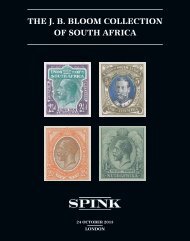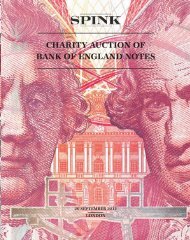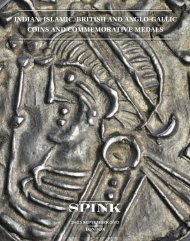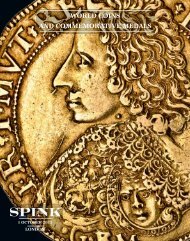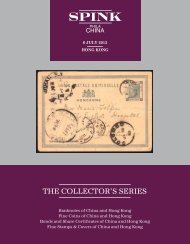issue of the 5th century which directly attests an imperialconsulship. The rarity of our coin is well in accord with otherissues from the period 423 to 425 since another centenionalistype from the same period was first published only in 1980 9 .Perhaps further types from this period might emerge in the future.* My best thanks go to Peter Scherrer for his permission topublish the coin and to Wolfgang Hahn for helpful discussion.Footnotes:1. A detailed treatment of all the coins found in Chamber J by the presentauthor, to be published in the respective volume of Forschungen inEphesus, edited by Peter Scherrer, is in print.2. J. P. C. Kent, The Roman Imperial Coinage. Vol. X. The Divided Empire andthe Fall of the Western Parts, AD 395–491 (London 1994), 92; 273,note 424.3. W. Hahn, Moneta Imperii Romani–Byzantini. Die Ostprägung des RömischenReiches im 5. Jahrhundert (408–491) (Wien 1989), 15.4. Hahn, op. cit., Prägetabelle I.5. Hahn, op. cit., 34 f., Prägetabelle I; Kent, op. cit., 91 f, 273f.6. Kent, op. cit., 271-277, 282 f.7. One emperor: Kent, op. cit., 254, no. 208 (dated 416), 260, no. 266(dated 435), 264, no. 330 (dated 444); two emperors: Kent, op. cit., 257,nos. 233-236 (dated. 424-425), 258, nos. 237-245 (dated 425-429).8. S. Bendall, Byzantine Weights. An introduction (London 1996), 18, no. 13.A further specimen turned up in Classical Numismatic Group, mail bidsale 73, 13. 9. 2006, no. 1024. The only difference between coin andexagium type is that on the latter, the star has been moved to the rightreverse field, possibly due to a die cutter’s mistake.9. W. Weiser, Eine neue Theodosianische Kleinbronze, Schweizer Münzblätter30/119 (1980), 69-71.Variations on a Theme – ESC510Malcolm LewendonThe William & Mary series of halfcrowns is short in datelengthwise, but of great interest to variety collectors – 2 busts,3 shields and various well documented crowns, Errors andoverstrikes also appear in the legends on both the obverse andreverse and a date error occurs on some 1693 specimens. ESCeven notes ‘contemporary forgeries’, which are of interest in theirown right.ESC510 (2nd shield, caul frosted + pearls) has proved to be aninteresting study as varieties with, and without, a stop after thedate have been noted.3. In (i), all the English lions have only one front leg, in (ii) theyhave two.4. The harp has 6 strings in (i) and 8 strings in (ii)5. There are minor differences to the Scottish lion.Since starting this study, a third variety has been identified thatcombines the stop after the date (i) with the crown and shield (ii)Numbering these varieties in relation to ESC is difficult as510A first appeared in the 2nd revised edition of 1957 and 510Bin the 4th revised edition of 1974, to denote other combinationsof frosting and pearls on 2nd shield coins. These should perhapsbe referred to as 510(i), (ii) and (iii). Rarities of each are hard toassess as there are very few examples in the market and it isdifficult to tell from a picture or scan whether a coin is 509 or510.All of my 1st shield examples have stops after the date, as do allmy other 2nd shield specimens, which have type (ii) crowns andshields except two examples of 509B, which have type (i). Tocomplicate it further, another 509B has a type (ii) crown andshield.It is possible that 510B, noted for inclusion in the 1974edition, could have been a 509 with very weak interior frosting. Ihave not seen a specimen of 510B for sale in the last eight years.A recent coin auctioned as 510B was, in fact, 509.ESC513 and 514 of 1690 have no stop, ESC515 has a stop. Myspecimens of 513 and 515 have the 2nd L of GVLIELMVS overanother L with a distinctly curved bottom. All three have a thirdvariety of shield with very large fleur-de-lis, 513 and 514 have 5harp strings whilst 515 has 6.(i) with stop(ii) without stopFurther investigation reveals many differences in the crown andshield as listed below:1. There is a distinct line at the top of the frosting on both sidesof the caul in (i). In (ii) this line is missing and the frostingextends further up the caul, nearly reaching the top of thecrown.2. In (i), the 3 fleur-de-lis in the top left and bottom right quartersof the shield are short and fat, whereas in (ii) they are tall andthin.It now remains to be seen if anybody has the 510 combination ofno stop (ii) with the crown and shield of (i) to make ESC510(iv).300 NUMISMATIC CIRCULAR
A George III ‘Cartwheel’ TwopenceCounterstamped with the Mark ofTwo London SilversmithsRobert SharmanThere was an error in the October edition of N.Circ:The surname of the first silversmith should have been Godbehereand not Gobehere.Book ReviewSylloge Nummorum Graecorum, Bulgaria, Ruse, Bobokov Bros.Collection, Thrace and Moesia Inferior, vol 1. Deultum.By Dimitar Draganov, Ruse (Bobokov Bros. Foundation), 2005.Pp. 303, 2010 coins illustrated on 134 plates.ISBN 954-9460-01-0 (vol. 1). £75.00This is the first in a projectedseries of SNG volumes that aimsat a comprehensive listing ofcoins of Thrace and MoesiaInferior. It covers the coinage ofa single mint, the colonia ofDeultum, and according to itsauthor, Dimitar Draganov,‘represents the most completecollection of coins of this city inthe world’. The collection wasformed by two brothers, Plamenand Atanas Bobokov, who ownan oil company and presumablyhave plenty of money to investin their project. They intend toamass the largest and mostcomplete body of material forthis region and, since the projectstill continues, it was decided to publish Deultum first becausethat mint was the most comprehensively covered. One hopes thatthe brothers Bobokov will maintain their interest so that theprocesses of both collecting and publishing will continue; it is alltoo easy for grandly-conceived projects like this to lose traction astime passes and their owners’ enthusiasms wane.This is not the first time an SNG volume has been consecratedto the coins of a single mint; one thinks of the SNG Slovenia,Ljubljana, Narodni Muzej for Viminacium (although one hopesthat further volumes of the Bobokov collection will appear morepromptly). Nor is it the first detailed listing of coins of Deultum.The city’s coinage has been the subject of an earlier monographby Jordanka Jurukova, Die Münzprägung von Deultum (Berlin,1973). Indeed, since the publication of this first Bulgarian SNG,Draganov himself has produced a monograph, The Coinage ofDeultum (Sofia, 2007). With the latter publication appearing sosoon after the volume reviewed here, one wonders to what extentthe material presented in the Bobokov brothers’ collection isrendered redundant for anyone who owns a copy. For those whodo not, however, this publication provides a wealth of illustrativedetail.Deultum was a fairly prolific mint, but its issues are restrictedto the reigns of Trajan (AD 98-117), Caracalla (211-217),Macrinus (217-218), Severus Alexander (222-235), Maximinus(235-238), Gordian III (238-244) and Philip (244-249). Thebulk of the coins in the Bobokov brothers’ collection are fromSeverus Alexander onwards, where coverage appears to be verycomprehensive: many coins presented are die duplicates. Thecoverage for Caracalla and Macrinus seems to be slightly lesscomprehensive, but it is nonetheless an impressive array ofmaterial and includes many types not in Jurokova. If anyoneshould care to work on Deultum after Draganov, this book willundoubtedly constitute a major resource.Many of the coin types can be paralleled on other Balkan issuesof the period, and one wonders what particular relevance theyhad for Deultum. Draganov does not provide any comments onany of them, presumably because these are reserved for hismonograph. In this respect SNG Bulgaria 1 differs from someother recent SNG publications like SNG Pfalz, where brief butuseful notes on types are sometimes provided, particularly in thevolumes compiled by Johannes Nollé. Most of the coins ofDeultum depict deities, which are given both their Roman andGreek names in the catalogue (Diana/Artemis, Aesculapius/Asclepius, Minerva/Athena, Cybele, Ceres/Demeter, Mercury/Hermes, Sarapis, etc.), and personifications (Aequitas/Dikaiosyne, City goddess, Concordia/Homonoia, Salus/Hygieia,Fortuna/Tyche, etc.). There are also typical colonial types such asthe standing Marsyas, the priest ploughing, and the wolf andtwins. A variety of temples are shown, sometimes in threequartersperspective (e.g. nos. 1348-1349). A rare type appearsto show the Capitoline Triad (no. 1626), and another a river godand Thalassa with a ship (nos. 1252-1254). Another unusualtype, showing Perseus and Andromeda with the sea monster,occurs frequently. Only two denominations were produced, andthe most intriguing type of all occurs only on the smaller: anonion-shaped object, usually shown standing on a small base.This Draganov describes as a fountain of Meta Sudans type;Jurokova describes it as a hive. On many of the coins this baseappears rounded while on others (e.g. no. 1918, which appearson the front cover of the volume) it is decorated with what lookslike a small, pedimented aedicula. One is reminded of cult imageswhich are sometimes shown with a small representation of theirtemple at the base, which raises the possibility that this type couldsignify something more than the mere glorification of civicplumbing or beekeeping. Could the similarity of its shape toimages of Telesphorus (who also appears exclusively on thesmaller denomination) be intentional? Without a commentary wedo not know what Draganov thinks.The plates are of high quality, with crisp, clear photographs,which is particularly important because the coins themselves arenot always particularly well-preserved (e.g. nos. 47-49, wherevery little detail can be seen). Diameters, weights and die axes aregiven along with brief descriptions and bibliographies for therelevant types, but die identities are not noted. Nor are anyprovenances given. One assumes they were all found in Bulgariabut not even that assumption is assured; all that we are told is thatthe material was collected over many years (though thephotograph of the brothers accompanying the preface of thebook suggest it cannot be that many years, unless the picture itselfis old) and that most of it comes from southern Bulgaria. Still, inpresenting us with unprovenanced material SNG Bulgaria 1 is nodifferent from most other SNG volumes.In recent years there has been a flurry of publications fromBulgaria dealing with the coinage of this region, as well as anoutpouring of the coinages themselves into western Europeanand American coin markets. One result of this is that there arenow a number of collectors who specialise in Balkan mints, forwhom this volume will be useful. In recent years, too, there hasbeen an outpouring of SNG volumes, some of variable quality.This, however, is a well-produced volume. Researchers will nodoubt find in it much useful data and illustrative material. It willbe attractive to collectors, although the price may well put it outof reach of all but the wealthiest and most earnest. Indeed, if therest of the collection maintains the same level of detail asDeultum then acquiring the entire series of Bobokov brothersvolumes will be a costly enterprise. All the same, it will beinteresting to see how the project develops. Each volume promisesto be a major reference work for the Balkan mints. We lookforward to future volumes.KEVIN BUTCHERDECEMBER 2008 301
- Page 1: NumismaticCircularDECEMBER2008Volum
- Page 4 and 5: SPINK & SON LTD69 Southampton RowBl
- Page 6 and 7: feasible that both these dies were
- Page 9: into the first twenty four years of
- Page 13 and 14: GK2607 Kingdom of Macedon, Demetrio
- Page 15 and 16: RomanAll minted at Rome unless othe
- Page 17 and 18: RM3934 Commodus (AD 177-192), Æ Du
- Page 19 and 20: HS3614 Early Uninscribed, ¡ Quarte
- Page 21 and 22: HS3643 William I, Penny, 1.44g, PAX
- Page 23 and 24: HS3664 Henry VIII, posthumous coina
- Page 25 and 26: HS3685 Charles I, Oxford, Shilling,
- Page 27 and 28: S09 Elizabeth I, Shilling, 5.87g, s
- Page 29 and 30: S33 Victoria, Shilling, 1880, type
- Page 31 and 32: Milled SilverCROWNSMS8695 William I
- Page 33 and 34: MS8707 Victoria, Crown, 1888, Jubil
- Page 35 and 36: MS8732 James II (1685-88), Sixpence
- Page 37 and 38: IO724 Iran, Qajar Dynasty, Fath ‘
- Page 39 and 40: 37 LE RIDER, G. Le Monnayage d’Ar
- Page 41 and 42: 133 JUDD, J.H. United States Patter



